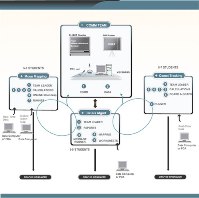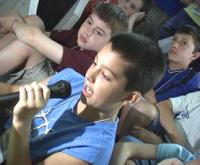Welcome to the Target Moon
live simulation website. Here, you will find
everything you need to run this simulation
effectively in your classroom.
What is the Target Moon
live simulation?
Target Moon is a live “mission” conducted in
your classroom through videoconferencing. It
features teams of students using real-time data
to complete the mission directive. The
accompanying website provides five to ten class
periods of mission preparation materials
including the standards addressed, scope and
sequence, lesson plans, and student materials.
Is this only for math
classes?
Target Moon was created to reinforce certain
math concepts for grades 5-8:
-
Recognize and apply
geometric ideas in areas outside the
mathematics classroom
-
Apply tools and use
formulas to accurately find the area of a
circle
-
Solve simple problems
involving rates and derived measurements for
velocity
-
Understand and apply
basic concepts of probability
The program is an innovative
way to engage students by integrating both math
topics and authentic space science in a
real-time context. The website includes
resources for integrating science topics.
How is the program used?
| Schedule date → |
Brief the students
→ |
Math lessons → |
Pre-Mission Prep → |
Conduct the mission |
-
Schedule a mission date
with the Challenger Learning Center.
-
“Brief” the students on
the mission.
-
Use lesson plans
provided on the website to reinforce the
relevant math concepts.
-
Prepare students for the
mission by completing a “mini-mission” to
apply math concepts.
-
Split students into
teams, set up the classroom with data
computers.
-
Test the
videoconference link with the Challenger Learning Center.
-
Conduct mission!
 In
what way is the simulation conducted in
“real-time”? In
what way is the simulation conducted in
“real-time”?
The mission is a student-centered,
team-based, interactive educational experience
that makes use of scientifically accurate data
to solve problems. Teachers run the simulations
in their own classrooms through the Internet
and a videoconferencing system. The classroom is
connected with a Flight Director from the CLC who
guides the problem-solving activities to a
successful conclusion.
In the Target Moon
simulation, students work in teams of 2-7 as
comet trackers, moon mappers, crisis managers,
and communicators. Teams work together to
evaluate the danger of an approaching comet to
lunar bases and astronauts. Comet trackers
follow the distance and time of impact for the
comet. Moon mappers determine the size of the
danger area and the probability of danger for
each lunar base. Crisis managers examine the
implications of the danger and make appropriate
recommendations to move astronauts and equipment
out of harm’s way. Communicators coordinate all
these activities with the mission director.
 Is
this just for fun or do students really learn? Is
this just for fun or do students really learn?
The program was designed by middle and high
school teachers, educational researchers, and
subject matter experts. Target Moon joins the
lineup of innovative distance learning programs
offered by the Challenger Learning Center and
the Center for Educational Technologies.
Simulations are an interactive way for you to
effectively use technology in your classroom.
Research indicates that this way of learning
leads to improved problem-solving and
critical-thinking skills and teaches students
the importance of teamwork and communication.
Shifting to digital learning
is critical to the success of education in
America. Target Moon creates an opportunity for
you to apply various technologies and provides
necessary digital content lacking in so many
computer classrooms.
Good luck on your mission!Download
Microsoft Active Accessibility. |

